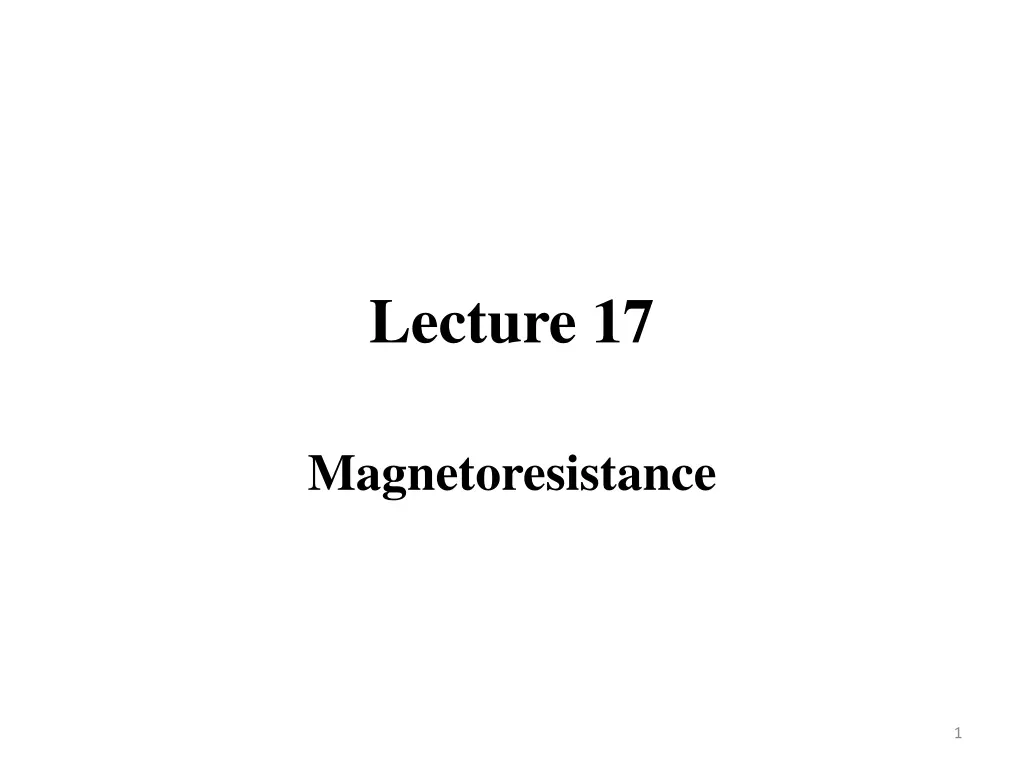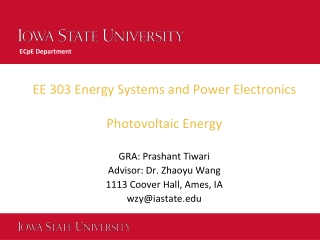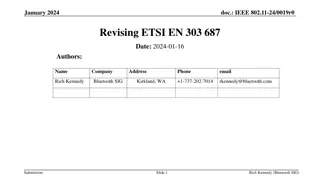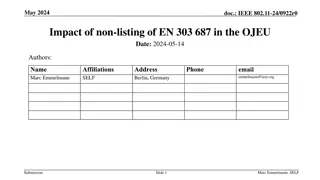
Understanding Magnetoresistance: Theory and Applications
Learn about magnetoresistance, a phenomenon where the resistance of certain materials changes in the presence of a magnetic field. Explore the working principle of magnetoresistors, the effect of magnetic fields on resistance, and how this property is utilized in various technologies such as computers for reading magnetic data.
Download Presentation

Please find below an Image/Link to download the presentation.
The content on the website is provided AS IS for your information and personal use only. It may not be sold, licensed, or shared on other websites without obtaining consent from the author. If you encounter any issues during the download, it is possible that the publisher has removed the file from their server.
You are allowed to download the files provided on this website for personal or commercial use, subject to the condition that they are used lawfully. All files are the property of their respective owners.
The content on the website is provided AS IS for your information and personal use only. It may not be sold, licensed, or shared on other websites without obtaining consent from the author.
E N D
Presentation Transcript
Lecture 17 Magnetoresistance 1
Recap Like the normal p-n junction diodes, LEDs also operates only in forward bias condition. A Light Emitting Diode (LED) consists of three layers: p-type semiconductor, n- type semiconductor and depletion layer. The p-type semiconductor and the n-type semiconductor are separated by a depletion region or depletion layer. In LEDs, the energy gap between conduction band and valence band is very large so the free electrons in LEDs have greater energy than the free electrons in silicon diodes. LEDs can emit different colors of light due to different wave lenght. 2
Magnetoresistance The resistance of some of the metal and the semiconductor material varies in the presence of the magnetic field, this effect is called the magnetoresistance. The element which has these effects is known as the magnetoresistor. In other words, the magnetoresistor is a type of resistor whose resistance varies with the magnetic field. The resistance of the magneto resistor is directly proportional to the magnetic field, i.e., their resistance raises with the increase of the magnetic field. The variation in resistance occurs because of the magneto effect. 3
Working Principle of Magnetoresistor It works on the principle of electrodynamics, which states that the force acting on the current place in the magnetic field changes their direction. In the unavailability of the magnetic field, the charge carriers of the magneto resistor move in the straight path. In the presence of the magnetic field, the direction of the current becomes changes, and it flows in the opposite direction. The indirect path of the current increases the mobility of their charge carrier which causes the collision. The collision increases the loss of energy in the form of heat. This heat increases the resistance of the magneto resistor. 4
The Effect of Magnetic Fields on Resistance Resistance is caused by collisions between charge carriers (like electrons) and other carriers or atoms. An electron moving through a perfect crystal of metal at a temperature of absolute zero will experience no collisions, so the crystal would have zero resistance. Imperfections, however, do exist, and temperatures above absolute zero cause the atoms to vibrate out of their lattice locations. These vibrations and imperfections cause collisions, increasing the resistance of the crystal. 5
The Effect of Magnetic Fields on Resistance Applying a magnetic field can also increase the resistance of a material, since the magnetic force on the moving charges will tend to increase the number of collisions between charges. This magnetoresistance. Magnetoresistance is proportional to the strength of the magnetic field, with a larger field producing a higher resistance. dependence of resistance on magnetic field is called This property is used in computers to read magnetic data. A potential difference is applied to a wire that is placed close to the magnetic material on disk or tape. As the magnetic fields representing data on the material pass by the wire, the resistance of the wire changes with the magnetic field of the data. This change in resistance changes the current through the wire. Monitoring this current provides a reading of the magnetic field on the tape or disk. 6
The Effect of Magnetic Fields on Resistance So, MR effect is the change of resistance denoted by R/Ro, which is proportional to the product of electron mobility and magnetic flux density, i.e., R/Ro ( B)2. / 0 is defined as: / 0= (B) 0/ 0=R(B) R0/R0 = R/Ro ( B)2. where (B) and 0 are resistivities in magnetic fields of a magnitude B and zero, respectively, and R(B) and R0 are similar electrical resistances, respectively. / 0 depends on the magnetic field B, i.e, its magnitude and direction as well. 7
Characteristic of Magnetoresistor The sensitivity of the magnetoresistor depends on the strength of the magnetic field. The characteristic curve of the magneto resistor is shown in the figure below. characteristic-curve In the absence of the magnetic field, the magnetization of the element becomes zero. When the magnetic field slightly increases the resistance of the material reaches near to b. The magnetoresistor element moves by an angle of 45 because of the presence of a magnetic field. The further increases in the magnetic field make the curve saturates, which is represented by the point C. 8
Types of Magneto resistor The magnetoresistor is classified into three categories: Giant Magnetoresistance (GMR) Extraordinary Magnetoresistance Tunnel Magneto Resistor 9
Giant Magnetoresistance (GMR) In this effect, the resistance of the magneto resistor becomes small when their ferromagnetic layers are parallel to each other. The resistance becomes very high for the antiparallel alignment of the layer. The construction of the GMR is shown in the figure below. magento-resistor 10
Extraordinary and Tunnel Magnetoresistance Extraordinary Magnetoresistance In this effect, the resistance of the metal is high in the absence of magnetic field and low in the presence of a field. Tunnel Magneto Resistor The current will flow from the one ferromagnetic electrode through the insulator. The magnitude of current flows through the tunnel depends on the direction of magnetization. 11
Summary Magnetoresistance is the tendency of a material (often ferromagnetic) to change the value of its electrical resistance in an externally-applied magnetic field. Vibrations and imperfections cause collisions, increasing the resistance of the crystal. This magnetoresistance. Magnetoresistance is proportional to the strength of the magnetic field, with a larger field producing a higher resistance. dependence of resistance on magnetic field is called 12






